
The cheetah has a slender, long-legged body with blunt semi-retractile claws. Its chest is deep and its waist is narrow.
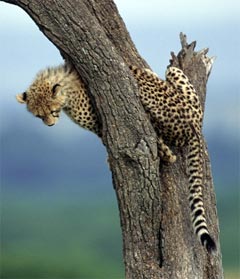 Sizes and Scales: The adult animal weighs from 40 to 65 kg (90 to 140 lb). Its total body length is from 112 to 135 cm (45 in to 55 in), while the tail can measure up to 84 cm (33 in). Male cheetahs are slightly larger than females and have a slightly bigger head, but it is difficult to tell males and females apart by appearance alone. Sizes and Scales: The adult animal weighs from 40 to 65 kg (90 to 140 lb). Its total body length is from 112 to 135 cm (45 in to 55 in), while the tail can measure up to 84 cm (33 in). Male cheetahs are slightly larger than females and have a slightly bigger head, but it is difficult to tell males and females apart by appearance alone.
Fur: the love of dots...The fur of the cheetah is yellow with round black spots, which help to camouflage it, and distinctive black lines that go from the inner corner of each eye and down along the side of the snout to the jaw. The cheetah's tail usually ends in a bushy white tuft.
King Cheetahs: Cheetahs also have a rare fur pattern mutation: cheetahs with larger, blotchy, merged spots are known as 'King Cheetahs'. It was once thought to be a separate subspecies, but it is merely a mutation of the African Cheetah. A 'King Cheetah' has only been seen in the wild a handful of times, but they have been bred in captivity.
Paws and Claws: The cheetah's paws have semi-retractable claws, unique among cat species, which offer the cat extra grip in its high-speed pursuits. It should be noted that the ligament structure of the cheetah's claws is the same as those of other cats; it simply lacks the sheath of skin and fur present in other varieties, and therefore the claws are always visible. With the exception of the dewclaw, the claw itself is also much shorter and straighter than other cats.
Speed Demon: The cheetah's flexible spine, oversized liver, enlarged heart, wide nostrils, increased lung capacity, and thin muscular body make this cat the swiftest hunter in Africa. Covering 7-8 meters in a stride, with only one foot touching the ground at a time, the cheetah can reach a speed of 110 km/h in seconds. At two points in the stride, none of its feet touch the ground.
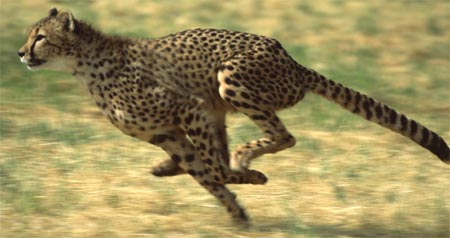
The cheetah is well known for its amazing acceleration (0-100 km/h in 3.5 seconds which is faster than the SLR McLaren, the Lamborghini Murciélago and the F/A-18 Hornet).
A Different Kind of Cat: Unlike true big cats, cheetahs can purr as they inhale, but cannot roar. By contrast, lions, tigers, leopards, and jaguars can roar but cannot purr, except while exhaling. However, cheetahs are still considered by many to be the smallest of the big cats. While it is often mistaken for a leopard, the cheetah does have distinguishing features, such as the long tear-drop shaped lines on each side of its nose that run from the corner of its eyes to its mouth. The body frame of a cheetah is also very different from that of the leopard, most notably so in its thinner and extra long tail.
Adaptability: not... The cheetah is a vulnerable species. Out of all the big cats, it is the least able to adapt to new environments. They have always proved difficult to breed in captivity, but recently a few zoos have been successful. Once widely shot for its fur, the cheetah now suffers more from the loss of both habitat and prey.
The cheetah is considered the most primitive of all cats, and until recently was thought to have evolved approximately 18 million years ago, although new research puts the last common ancestor of all 37 existing species of feline more recently, at 11 million years. The cheetah has lions and hyenas as natural enemies.

Females: Unlike males, females are solitary and tend to avoid each other, though some mother/daughter pairs have been known to continue for small periods of time. Cheetahs have a unique, well-structured social order.
Single Mother: Females live alone except when they are raising cubs and they raise their cubs on their own.
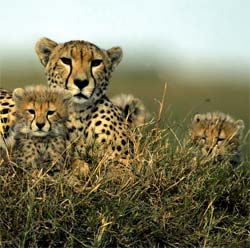 The first 18 months of a cub's life are important - cubs learn many lessons because survival depends on knowing how to hunt wild prey species and avoid other predators such as leopards, lions, hyena, and baboons. The first 18 months of a cub's life are important - cubs learn many lessons because survival depends on knowing how to hunt wild prey species and avoid other predators such as leopards, lions, hyena, and baboons.
At 18 months, the mother leaves the cubs, who then form a sibling, or 'sib', group, that will stay together for another 6 months. At about 2 years, the female siblings leave the group, and the young males remain together for life. Life span is up to 12 years in wild, but up to 20 years in captivity.
Males: Male cheetahs are very territorial. Unfortunately, female cheetahs' home ranges can be very large and trying to build a territory around several females' ranges is impossible to defend. Instead, males choose the points at which several of the females' home ranges overlap, creating a much smaller space which can be properly defended against intruders while maximizing the chance of reproduction. Coalitions will try their utmost to maintain territories in order to find females with which they will mate. The size of the territory also depends on the available resources and depending on the part of Africa, the size of a cheetah's territory can vary greatly from 37 km2 to 160 km2.
Social Butterflies: Male cheetahs are very sociable and will group together for life, usually with their brothers in the same litter, although if a cub is the only male in the litter then two or three lone males may group up or a lone male may join an existing group. These groups are called coalitions. A coalition is six times more likely to obtain a territory than a lone male, although studies have shown that coalitions keep their territories just as long as lone males - four to four and a half years.
Males mark their territory by urinating on objects that stand out, such as trees, logs or termite mounds. The whole coalition contributes to the scent. Males will attempt to kill any intruders and fights often result in serious injury or death.
Unlike males and other felines, females do not establish territories. Instead the area they live in is termed a home range. These overlap with other females' home ranges; often, it will be the females from the same litter or a daughter's home range overlapping with her mother's.
Home Range: The size of a home range depends entirely on the availability of prey. Cheetahs in African woodlands have ranges as small as 34 km square, while in some parts of Namibia they can reach 1500 km square. Although there have been no studies, it is expected that the home ranges of females in the Sahara are the largest of all the cheetah populations.
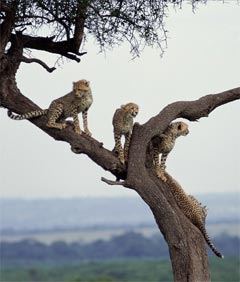 Communication Nation: When cheetahs attempt to find each other, or a mother tries to locate her cubs, they use high-pitched barking called yipping. The yips made by a cheetah cub sound more like a bird chirping, and so are termed chirping. Communication Nation: When cheetahs attempt to find each other, or a mother tries to locate her cubs, they use high-pitched barking called yipping. The yips made by a cheetah cub sound more like a bird chirping, and so are termed chirping.
Churring, stuttering or stutter-barking is a vocalization emitted by cheetahs during social meetings. A churr can be seen as a social invitation to other cheetahs, an expression of interest, uncertainty or appeasement or during meetings with the opposite sex (although each sex churrs for different reasons).
Growling, often accompanied by hissing and spitting are exhibited by cheetahs during annoyance, or when faced with danger. A similar vocalization made by a cheetah when a threat is escalated is yowling.
Purring is made when the cheetah is contented, usually during pleasant social meetings (e.g. a mother with her cubs).
Hungry, Hungry Hunter: Cheetahs are carnivores, eating mostly mammals under 40 kg (90 lb), including Thomson's gazelles and impala. Wildebeest and calves are hunted when cheetahs hunt together. Guinea fowl and hares are also hunted. While the other big cats mainly hunt by night, the cheetah is a diurnal hunter. It hunts usually either early in the morning or later in the evening when it is not so hot, but there is still enough light - cheetahs hunt by vision rather than by scent.
Prey is stalked to within ten to thirty meters (30-100 ft), then chased. Using their tails to maintain balance, cheetahs can make sharp turns if needed. Cheetahs are able to run at 60-70 miles an hour, but they chase their prey at only about half the speed. The chase is usually over in less than a minute and if the cheetah fails to make a quick catch, it will often give up rather than waste energy.
Cheetah Table Manners: Roughly half of their chases are successful. The cheetah kills its prey by tripping it during the chase, then biting it on the underside of the throat to suffocate it, for the cheetah is not strong enough to break the necks of the gazelles it mainly hunts. The bite may also puncture a vital artery in the neck. Then the cheetah proceeds to devour its catch as quickly as possible before the kill is taken by stronger predators such as lions, leopards and hyenas.
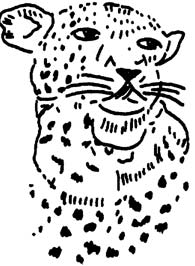 Domesticated Cheetahs? In much of their former range they were domesticated by aristocrats and used to hunt antelopes in much the same way as is still done with members of the greyhound group of dogs. Aside from an estimated 200 cheetahs living in Iran (Khorasan Province), the distribution of cheetahs is now limited to Africa. There are 5 subspecies of cheetah in the genus Acinonyx: four in Africa and one in Iran. Domesticated Cheetahs? In much of their former range they were domesticated by aristocrats and used to hunt antelopes in much the same way as is still done with members of the greyhound group of dogs. Aside from an estimated 200 cheetahs living in Iran (Khorasan Province), the distribution of cheetahs is now limited to Africa. There are 5 subspecies of cheetah in the genus Acinonyx: four in Africa and one in Iran.
Out of India: The endangered subspecies Acinonyx jubatus venaticus lives in Asia (Iran). In 1990, there were reports in the Times of India of a cheetah sighting in eastern India. There is a chance some cheetahs remain in India, though it is doubtful. There have also been reports of Asiatic cheetahs in the Balochistan Province of Pakistan, though these continue to be unverified. The cheetah prefers to live in an open biotope, such as semi-desert, prairie, and thick brush.

The genus name, Acinonyx, means "no-move-claw" in Greek, while the species name, Justus, means "manned" in Latin, a reference to the mane found in cheetah cubs. It is the only cat that cannot completely retract its claws. Even when retracted, the claws remain visible and are used for grip during the cheetah's acceleration and maneuvering, performing the same function as canine claws.
The English word "cheetah" comes from Hindi chit, which is perhaps derived from Sanskrit shiitake, meaning "the spotted one". Other major European languages use variants of the medieval Latin gatt us pads, meaning "cat-leopard i.e. spotted cat": French geared; Italian Sheppard; Spanish and Portuguese geared (also used chit); and German geared.
Cheetahs have unusually low genetic variability and high abnormal sperm count. Skin grafts between non-related cheetahs illustrate this point in that there is no rejection of the donor skin. It is thought that they went through a prolonged period of inbreeding following a genetic bottleneck during the last ice age. They probably evolved in Africa during the Miocene epoch (26 million to 7.5 million years ago), before migrating to Asia. New research by a team lead by Warren Johnson and Stephen O’Brien of the Laboratory of Genomic Diversity (National Cancer Institute in Frederick, Maryland, US) has recently placed the last common ancestor of all existing cat species as living in Asia c. 11 million years ago, which may lead to revision and refinement of existing ideas about cheetah evolution.
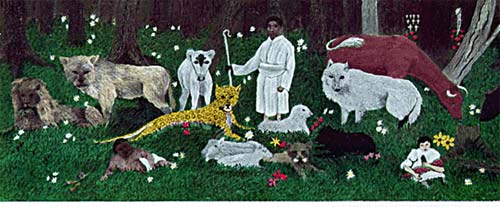
All text is available under the terms
of the GNU Free Documentation License
|